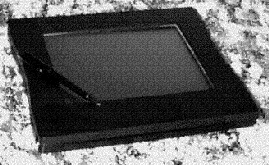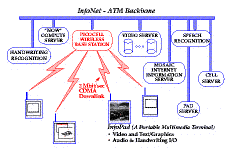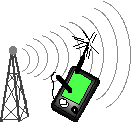
 |
JPL's Wireless Communication Reference WebsiteChapter: Network Concepts and Standards |
 A key to the success of future Personal Communications Systems will be
terminals that allow users to have untethered access to fixed
multimedia information servers. The portability requirement
imposed by these terminals will place
severe constraints on the total power consumption.
A key to the success of future Personal Communications Systems will be
terminals that allow users to have untethered access to fixed
multimedia information servers. The portability requirement
imposed by these terminals will place
severe constraints on the total power consumption.
 To explore low power design, a portable multimedia terminal, the InfoPad,
which supports speech I/O, a pen input, text/graphics output and full-motion
video is being implemented. The availability
of communications between the terminal and computational resources at
a fixed base-station at the other end of the
wireless link provides a major degree of freedom for optimizing power; i.e any
computation that does not have to be performed on the terminal (such as general
purpose computation or application specific tasks such as speech
and handwriting recognition) can be removed from the terminal.
Other techniques for achieving low-power include optimizing
algorithms for minimal switching activity,
using parallel architecture that enables slow and low-voltage operation,
optimizing memory structures for reduced capacitance, and utilizing
low-power cell libraries.
To explore low power design, a portable multimedia terminal, the InfoPad,
which supports speech I/O, a pen input, text/graphics output and full-motion
video is being implemented. The availability
of communications between the terminal and computational resources at
a fixed base-station at the other end of the
wireless link provides a major degree of freedom for optimizing power; i.e any
computation that does not have to be performed on the terminal (such as general
purpose computation or application specific tasks such as speech
and handwriting recognition) can be removed from the terminal.
Other techniques for achieving low-power include optimizing
algorithms for minimal switching activity,
using parallel architecture that enables slow and low-voltage operation,
optimizing memory structures for reduced capacitance, and utilizing
low-power cell libraries.
 Figure: Schematic of Infopad wireless computing environment. See an enlargement.
|  Hear P.I. Bob Brodersen speak about the project.
| 
Slides describing the project |
 High radio link performance, spectrum efficient
network design and low terminal power consumption are the main design criteria. To reduce the power
consumption in the terminal, almost all computational tasks are to be performed in the backbone network,
either at the base station or remotely, making the terminal mainly an Input/Output device. The diagram below shows a
schematic of the system. The wireless terminal is in full-duplex communication with a networked base
station, which serves as a gateway between the wired and wireless network. Through this base station, a user
can access services over the high-speed communications backbone, or communicate with another person
who is also linked into the network.
High radio link performance, spectrum efficient
network design and low terminal power consumption are the main design criteria. To reduce the power
consumption in the terminal, almost all computational tasks are to be performed in the backbone network,
either at the base station or remotely, making the terminal mainly an Input/Output device. The diagram below shows a
schematic of the system. The wireless terminal is in full-duplex communication with a networked base
station, which serves as a gateway between the wired and wireless network. Through this base station, a user
can access services over the high-speed communications backbone, or communicate with another person
who is also linked into the network.
 The portable multi-media terminals will offer access to large commercial databases that contain transitory information such as international and domestic news, financial information, traffic data, transportation
schedules, voice and electronic mail, telephone directories, etc. For several years, information such as
encyclopedias and data bases have been distributed via CD-ROM in a relatively static form. Not only can
these services be provisioned in a more dynamic format via a wireless radio link, but they can be offered in
a more physically comfortable setting by minimizing the weight that a user must carry. The multi-media
terminal envisioned would also be able to provide a user interface in an X-windows distributed computing
environment. The X-functions are presumably best performed in the local base station, where processing
power is abundant, while computations and data base searches are done remotely. Intensive task can be
performed by supercomputers connected with base stations through a high speed backbone network.
The portable multi-media terminals will offer access to large commercial databases that contain transitory information such as international and domestic news, financial information, traffic data, transportation
schedules, voice and electronic mail, telephone directories, etc. For several years, information such as
encyclopedias and data bases have been distributed via CD-ROM in a relatively static form. Not only can
these services be provisioned in a more dynamic format via a wireless radio link, but they can be offered in
a more physically comfortable setting by minimizing the weight that a user must carry. The multi-media
terminal envisioned would also be able to provide a user interface in an X-windows distributed computing
environment. The X-functions are presumably best performed in the local base station, where processing
power is abundant, while computations and data base searches are done remotely. Intensive task can be
performed by supercomputers connected with base stations through a high speed backbone network.
In this approach, almost no error-critical data is sent over the wireless link. Since most of the image processing and X-server functions are performed in the base station, the power consumption in the terminal can be kept small. It implies that the wireless link to the terminal needs to support dynamic screen data at high rate. This requires a downlink (base station to terminal) with relatively high bandwidth, which may however tolerate occasional signal outages during periods of excessive channel load by other users. The tolerance of signal outages substantially reduces the transmission overhead that would be required other- wise to achieve almost error free exchange of data.
The situation in the uplink is quite different: Many existing notebook computers use a key pad for entering data into the system, but simplified entry mechanisms such as voice recognition and hand-writing recognition are likely to be available in the near future. In order to minimize terminal power consumption, speech recognition will be performed in the base station rather than in the terminal itself. Speech compression techniques have been refined and are available for instance for GSM digital telephony. Such schemes are likely to allow power efficient implementation in the near future. These schemes imply that the uplink (terminals-to-base station) only needs to support relatively low bit rates, say up to 10 kbit per second in a burst mode.

 Audio
Audio PDF document: Slides describing
the project.
PDF document: Slides describing
the project.

